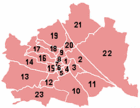Neubau
You can help expand this article with text translated from the corresponding article in German. (December 2009) Click [show] for important translation instructions.
|
Neubau
Neibau (Bavarian) | |
|---|---|
7th District of Vienna | |
|
NEOS 3 | |
| Area | |
| • Total | 1.61 km2 (0.62 sq mi) |
| Population (2016-01-01)[1] | |
| • Total | 32,027 |
| • Density | 20,000/km2 (52,000/sq mi) |
| Postal code | 1070 |
| Address of District Office | Hermanngasse 24-26 1070 Wien |
| Website | www |
Neubau (German pronunciation: [ˈnɔʏbaʊ] ⓘ; Viennese: Neibau; "New Building") is the seventh district of Vienna (German: 7. Bezirk). It is located near the center of Vienna and was established as a district in 1850, but borders changed later.[2] Neubau is a heavily populated urban area, with a major shopping area and residential buildings.[2] It has a population of 32,027 people (as of 2016-01-01) within an area of 1.61 km² (0.62 sq.mi.).
It consists of the former Vorstädte of Neubau, Altlerchenfeld, St. Ulrich, Schottenfeld and Spittelberg. The district borders are formed by Lerchenfelder Straße in the north, Mariahilfer Straße in the south, Neubaugürtel in the west, and Museumstraße and Museumsplatz in the east.
History
In the 18th century, Neubau was the location of the city's
In the
In the 2004 European elections the Green Party received 41% of all votes, which is more than Social Democratic Party and Austrian People's Party together.
Like Mariahilf, Neubau is known as one of Vienna's districts with the youngest, most liberal, and urban population.


Politics
| District Directors since 1945 | |
|---|---|
| Josef Matz (KPÖ) | 4/1945 -7/1945 |
| Wilhelm Dürnbacher (ÖVP) | 1945–1950 |
| Ferdinand König (ÖVP) | 1950–1954 |
| Franz Glamm (ÖVP) | 1954–1959 |
| Peter Platzer (ÖVP) | 1959–1964 |
| Franz Pospisil (ÖVP) | 1964–1965 |
| Otto Limanovsky (ÖVP) | 1965–1978 |
| Josef Karrer (ÖVP) | 1978–1991 |
| Herbert Tamchina (SPÖ) | 1991–1998 |
| Gabriele Zimmermann (SPÖ) | 1998–2001 |
| Thomas Blimlinger (Greens) | 2001-2007 |
| Markus Reiter (Greens) | 2007- |
After the
At the 2010 elections, the Greens increased their vote, the Liberal Forum vote remained at 1.1%, and the BZÖ increased their vote from their 2005 level of 0.8% to 1.1%.
| Jahr | SPÖ | ÖVP | FPÖ | Grüne | LIF | BZÖ | Sonstige |
| 1991 | 32.2 | 28.5 | 17.1 | 20.1 | -- | -- | 2.1 |
| 1996 | 27.2 | 21.4 | 19.7 | 18.8 | 10.2 | -- | 2.8 |
| 2001 | 29.4 | 17.9 | 14.4 | 32.6 | 4.7 | -- | 1.0 |
| 2005 | 27.5 | 18.1 | 7.3 | 43.3 | 1.2 | 0.8 | 1.9 |
| 2010 | 25.4 | 13.9 | 10.7 | 45.4 | 1.1 | 1.1 | 2.5 |
This district was the first in 2001 and until the 2004 (European Elections 2004) the only district in Austria where the Greens had a relative majority (plurality).
People
This section needs expansion. You can help by adding to it. (December 2009) |
- Johann Christoph Voigtländer (1732–1797) (de)
- Josef Lanner(1801–1843)
- Carl Michael Ziehrer (1843–1922) (de)
- Gustav Klimt (1862–1918)
- Karl Farkas (1893–1971)
- Fritz Hochwälder (1911–1986)
- Fritz Muliar (1919–2009)
- Theodor Graf Latour (de)
Sankt Ulrich
- Johann Strauß II(1825–1899), born here
Historic sites
- St. Ulrich
Notes
- ^ Statistik Austria - Bevölkerung zu Jahresbeginn 2002-2016 nach Gemeinden (Gebietsstand 1.1.2016), Statistik Austria.
- ^ a b Wien.gv.at webpage (see below: References).
- ^ Stadt Wien Archived 2007-12-27 at the Wayback Machine
References
- "Wien - 7. Bezirk/Neubau", Wien.gv.at, 2008, webpage (15 subpages): Wien.gv.at-neubau (in German).
- ISBN 3-85058-065-2.
- Manfred Lang: Ein neuer Neubau: Geschichte der Sozialdemokratie am Neubau. Verl. d. SPÖ Wien, Vienna 1989.
- ISBN 978-3-8000-7306-1.
External links
- Mariahilferstrasse: Vienna's largest shopping street.
- Museumsquartier: Centre for culture and modern art.
- Volkstheater Wien: Peoples Theatre, founded in 1887-89 by architects F. Fellner and H. Helmer.
- results of the last elections (official web site of Vienna)

